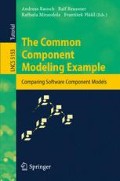Abstract
In this chapter we present a version of the Trading System case study modeled according to the KobrA approach. KobrA is a UML-based method for describing components and component-based systems developed at the Fraunhofer Institute for Experimental Software Engineering at the beginning of the decade. The acronym stands for the term “Komponenten basierte Anwendungsentwicklung” – German for “Component-based Application Development”. KobrA has been successfully used by a number of companies in industrial settings and has given rise to numerous specializations and offshoots (e.g. MARMOT [1] and MORABIT [2]). The original version of the method [3] was developed for the UML 1.x flavor of the UML, but in this chapter we introduce an updated version optimized for use with the 2.x versions of the UML [4] and its related standards such as OCL [5]. KobrA also provides support for other advanced software engineering approaches such as product-lines, but these are beyond the scope of this chapter. Here we focus on the component-modeling aspects of the method.
Access this chapter
Tax calculation will be finalised at checkout
Purchases are for personal use only
Preview
Unable to display preview. Download preview PDF.
References
Fraunhofer Institute for Experimental Software Engineering: The MARMOT Project - Component-based Development of Embedded Systems (2003), http://www.marmot-project.de/de/home/index.html
Brenner, D., Atkinson, C., Paech, B., Malaka, R., Merdes, M., Suliman, D.: Reducing Verification Effort in Component-Based Software Engineering through Built-In Testing. In: Proceedings of the International IEEE Enterprise Computing Conference (EDOC 2006), 16th-20th October, Hong Kong (2006)
Atkinson, C., Bayer, J., Bunse, C., Kamsties, E., Laitenberger, O., Laqua, R., Muthig, D., Paech, B., Wüst, J., Zettel, J.: Component-Based Product Line Engineering with UML, 1st edn. Addison Wesley, Reading (2001)
OMG: UML 2.0 Superstructure Specification (2003), http://www.omg.org/docs/ptc/03-08-02.pdf
Warmer, J., Kleppe, A.: The Object Constraint Language: Precise Modeling with UML. Addison-Wesley Longman Publishing Co., Inc., Boston (1998)
OMG: MDA Guide Version 1.0.1 (2003), http://www.omg.org/docs/omg/03-06-01.pdf
Ambler, S.W.: Agile Modeling (2006), http://www.agilemodeling.com
Clements, P., Northrop, L.: Software Product Lines. Addison-Wesley, Boston (2002)
Bayer, J., Flege, O., Knauber, P., Laqua, R., Muthig, D., Schmid, K., Widen, T., Debaud, J.M.: PuLSE. A Methodology to Develop Software Product Lines. In: Proceedings of the Symposium on Software Reuse (SSR 1999) (1999)
Larman, C.: Applying UML and Patterns: An Introduction to Object-Oriented Analysis and Design, 3rd edn. Prentice-Hall, Englewood Cliffs (2005)
Coad, P., Mayfield, M.: Coad, Yourdon, and Nicola: OOA, OOD, & OOP. Wiley-QED Publishing, Somerset (1994)
OMG: Business Process Modeling Notation Specification - version 1.0. Final Adopted BPMN 1-0 Spec 06-02-01.pdf (2006), http://www.bpmn.org/Documents/OMG
Scheer, A.W.: ARIS - Modellierungsmethoden, Metamodelle, Anwendungen. Springer, Heidelberg (2001)
Coleman, D., Arnold, P., Bodoff, S., Dollin, C., Gilchrist, H., Hayes, F., Jeremaes, P.: Object-Oriented Development. The Fusion Method. Prentice-Hall, Englewood Cliffs (1994)
OMG: UML Profile for Schedulability, Performance and Time (2005), http://www.omg.org/cgi-bin/doc?formal/2005-01-02
OMG: UML Profile for Modeling QoS and Fault Tolerance Characteristics and Mechanisms (2006), http://www.omg.org/cgi-bin/doc?formal/06-05-02
Author information
Authors and Affiliations
Editor information
Rights and permissions
Copyright information
© 2008 Springer-Verlag Berlin Heidelberg
About this chapter
Cite this chapter
Atkinson, C. et al. (2008). Modeling Components and Component-Based Systems in KobrA. In: Rausch, A., Reussner, R., Mirandola, R., Plášil, F. (eds) The Common Component Modeling Example. Lecture Notes in Computer Science, vol 5153. Springer, Berlin, Heidelberg. https://doi.org/10.1007/978-3-540-85289-6_4
Download citation
DOI: https://doi.org/10.1007/978-3-540-85289-6_4
Publisher Name: Springer, Berlin, Heidelberg
Print ISBN: 978-3-540-85288-9
Online ISBN: 978-3-540-85289-6
eBook Packages: Computer ScienceComputer Science (R0)

